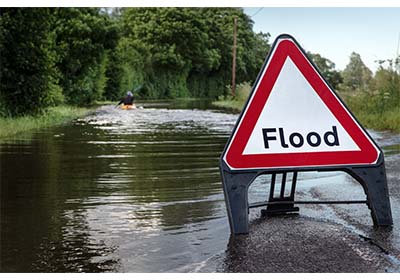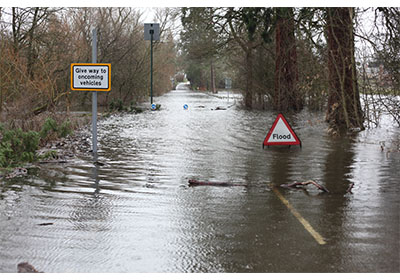
How to Drive Through Fords and Flood Water
By Soraya Pathmanandam,
26 September 2024, 10 min read
According to the Met Office, the United Kingdom has experienced a significant increase in heavy rainfall the last decade which in turn increases the risk of flooding.
In the UK, flooding typically occurs when heavy rainfall sees the drainage systems overwhelmed, and rivers burst their banks.
Some areas of the UK that are more susceptible to flooding are:
Coastal areas
Towns and villages near rivers
Floodplains
Fords
Should I drive through floodwater?
It is sensible to avoid driving if you know, or suspect, your route may be flooded. Flooded roads present a risk to you, your passengers and other road users. In addition, your vehicle could be written off if water isn't navigated properly.
If you must drive or are already on the road and encounter a flood, you should stop, turn back and find an alternative route.
If it is not possible to turn back, we’ve assembled a guide on driving through flood water safely.

Risks of driving through floodwater
There are many risks associated with driving through flooded areas, for instance:
Risks to people:
Becoming trapped in vehicles which fill with water
Losing traction on wet roads causing a crash, injuring drivers, passengers and pedestrians
Having to abandon a vehicle and getting swept away by flood water
Splashing a pedestrian (this can also lead to a fine of £5000)
Urban floodwater can carry dangerous bacteria from the drains to the surface, whereas rural floodwater may contain animal faeces and chemicals used for farming
Risks to vehicles:
Hydro-locking engine occurs when water enters the vehicle’s engine, seizing it beyond economical repair. A new engine is costly and unlikely to be covered by insurance if the driver chose to enter the water.
Damaged radiator can be caused by debris hitting the cooling fins or the car hitting a body of water too fast. Damaged radiators can leak coolant causing overheating and permanent engine damage.
Damage to body work can be caused by entering water too quickly, or by floating debris coming up against the car body. Bumpers and number plates are among the most common losses when travelling through water.
Electrical issues caused by water invading the electrical systems causing shorts or burning out actuators and motors. In some cases, this might render the car undriveable.
Risks whilst driving:
Aquaplaning occurs when water builds up on the road surface, so as to reduce traction between the road and the tyres of a vehicle. When this happens, the vehicle slides across the road and can be difficult to recover. There is a risk that the vehicle hits pedestrians or other vehicles or objects.
Dips and holes may be hidden by murky floodwater. Hitting a pothole at speed can damage tyres, wheels and suspension, whereas sudden dips may cause the vehicle to veer off course, risking a collision.
Can my 4x4 drive through water?
4x4’s aren’t immune to water damage from flooding. 4x4’s and all-wheel drive vehicles still have a maximum recommended wading depth. This may be slightly higher than a normal car due to increased ground clearance. Many 4x4s that come with factory fitted raised air intakes (snorkels) as standard can still let water in via engine breathers and un-sealed areas such as the air filter housing. Unless your 4x4 has been specially adapted for “wading” you should follow the same advice as for cars.
What to check before driving in floodwater
If you must drive through a flooded area or road then there are some things you need to consider :
Check your tyres
Check the condition and tread depth of your tyres as this is vital for having control of your steering and braking. The tread depth of your tyres affects your stopping distance since the tyre tread helps move water, mud, and debris away from the tyre’s contact with the road.
A shallow tread depth causes a build-up of water as it can’t be dispersed fast enough which increases the risk of skidding or aquaplaning.
The legal minimum tread depth is 1.6mm but it is recommended to get them replaced when they drop below 3mm
Assess the depth of the water before driving into it
Don’t drive through moving water or water that is more than 4 inches deep. If you wouldn’t walk through it, definitely don’t drive through it. The average wading depth is 4 inches, as most car air intakes are around that height.
If water enters the air intake, it will be sucked into engine which can cause a hydrolock – effectively making the engine uneconomical to repair.
How to drive safely through floodwaters
- Reduce your speed to 3-4mph
Driving slowly through a flood prevents water from going over the bonnet of the vehicle. If water goes over the bonnet, it is likely to have already entered the air intake and other sensitive areas. Driving at a reduced speed h forces water away from your vehicle’s air intake and vulnerable areas.
- Don’t change gear
Whilst driving through water, don’t change gears, this is to avoid stalling in the middle of the flooded area, but also to reduce the chance of water contaminating your clutch and transmission.
- Drive along the middle or highest part of the road
Most roads are highest at the middle; therefore, the water will be shallower there making it easier to get through.
- Keep extra distance between vehicles
When following another car, allow some distance between you in case they get stuck, breakdown or lose control of their vehicle.
Remember, in wet conditions stopping distances and brake effectiveness are both significantly reduced.
- Pass through flooded sections one car at a time
If cars pass each other coming through a flood, there is a risk that one’s bow wave will go over the bonnet of the other. It is safest to go through one vehicle at a time, giving way to oncoming vehicles first.

- Use higher revs than usual
When driving through floods, you should increase your engine revs to prevent both water from entering your exhaust and the likelihood of you stalling the engine.
For manual transmissions: slightly let off the clutch while pressing the accelerator to increase the engine speed.
For automatic transmission: select the lowest held gear and keep your foot on the accelerator.
- Keep moving, don’t stop
When driving through floods, you keep moving until you’re out of the water. Stopping in the middle of water can be dangerous, allowing water to enter the engine or into the vehicle cabin via door seals, putting both you and vehicle at risk.
- Test your brakes after
After driving through the flooded area, you should gently apply your brakes a few times. This will aid in drying your brakes due to friction-generated heat and give you reassurance they’re still working for the rest of your drive.
How to drive through fords and river crossings
According to the AA, more than half of flood related breakdowns are at fords – points at which the road passes through a river.
Our advice for navigating fords is much the same as for flood water:
If you’re not confident driving through a ford, then find an alternative route
Don’t assume that a ford is safe to cross just because it has been in the past
Fords normally have a depth indicator to show how deep the water is, but if you can’t tell do not risk driving through, the advice is still to avoid water deeper than 10cm (4”)
Moving water as deep as 6” is enough to sweep away the average car, so avoid crossing when there is a visible current and the depth exceeds 10cm (4”). Due to the nature of a ford (a river crossing the road) the risk of being swept down the river and off the road is high)
Test your brakes after crossing
When an area is experiencing flooding, fords are best avoided due to the increased risk.
Does breakdown cover flood damage?
Breakdown cover generally won’t cover you if you choose to drive through floodwater, so check your policy wording before setting off.